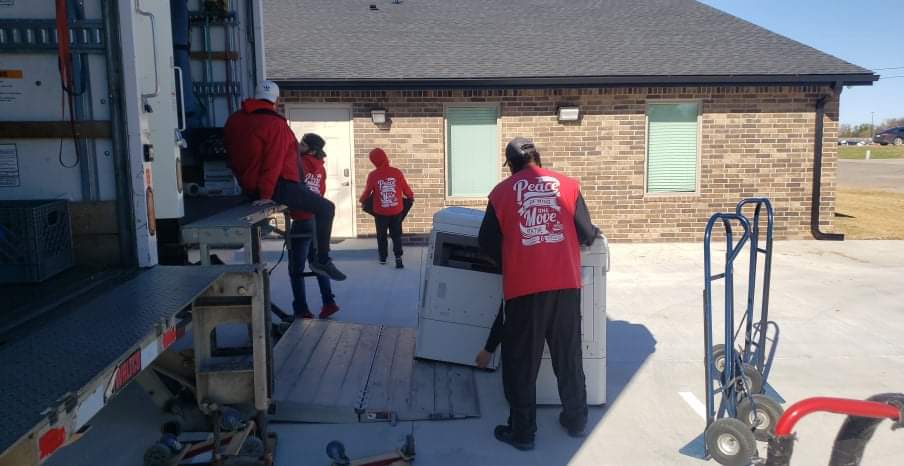
If you don’t want to leave your fridge behind when moving, you should learn some tips and tricks to move it safely. Since fridges are bulky, it’s essential that you don’t hurt yourself during the move and also avoid damaging your fridge. Mishandling a refrigerator while moving can also cause costly damage and even a complete breakdown of the unit. This blog provides everything you need to know to relocate your fridge safely to a new destination.
Why It’s Important to Move Refrigerators Properly
First, let’s talk about why it’s so important to move your fridge properly. While your safety comes first, there’s also a risk of damaging different parts of your fridge.
Your Safety
Without the right equipment and techniques, it’s easy to injure your back, pull a muscle, or lose control of the appliance entirely. Always make sure you have the right equipment on hand to avoid injuring yourself.
Preventing Damage to the Compressor
If you move your fridge improperly, you could end up damaging its most vital components, especially the compressor. The compressor is responsible for keeping your refrigerator cold, and shifting or jostling it during a move may make the fridge stop working altogether.
Avoiding Refrigerant Leaks
There is also a risk of refrigerant leaks. If the fridge loses any refrigerant, not only will it not cool properly, but it could also pose an environmental hazard.
Exterior Damage
Beyond the internal components, exterior dents and scratches are common when heavy appliances like fridges are not handled with sufficient care.
Equipment You’ll Need to Move a Fridge
Before you begin, gather all necessary tools and materials to move your refrigerator safely. When you get the right equipment, it makes all the difference.
Furniture Dolly or Appliance Dolly
A sturdy dolly is one of the most important tools for moving your fridge. It supports the heavy weight of the appliance, helps protect your floors, and significantly reduces the risk of injury. Fridges are awkward to lift not only due to their size, but also their weight distribution. A dolly allows you to roll your fridge smoothly from one room to another and even up and down stairs. Ensure you use a model that’s rated for large appliances and has securing straps or a lip to prevent sliding.
Moving Straps
Moving straps are made to help you lift large, heavy appliances both more safely and more efficiently. They distribute the refrigerator’s weight evenly across your body, which can prevent muscle strain and reduce the chances of dropping the unit. Straps also provide better control over the fridge’s movement, especially in tight spaces or on staircases. They are beneficial when you don’t have someone available to help with lifting.
Protective Blankets and Wrapping
Moving blankets, padded wraps, and even thick quilts can protect the refrigerator’s exterior from scratches, scuffs, and dents while in transit. If you are navigating doorways, hallways, or tight corners, padding helps prevent accidental impact damage. It also cushions the appliance during bumps or sudden stops on the road. For extra security, wrap the fridge in blankets and then secure them with stretch wrap or strong moving tape.
Gloves and Appropriate Footwear
Always wear thick, non-slip work gloves when handling your fridge. Not only will they give you a firmer grip on the appliance, but they will also protect your hands from sharp edges and prevent pinched fingers when maneuvering through tight spaces. Since refrigerators can become slippery, especially when condensation is left over after defrosting the freezer, wearing gloves makes a big difference in safety.
How to Move a Fridge?
Here is a step-by-step guide for moving your fridge.
Check Manufacturer Guidelines
Always start by checking the owner’s manual. Different refrigerator models may have unique handling or transport recommendations. The manufacturer might warn against tilting the appliance too far or offer specific instructions for transporting upright units. If you have misplaced your manual, many manufacturers have digital versions available online.
Empty the Fridge
Remove everything from your fridge and freezer, including not only food and ice trays, but also loose shelves and drawers. Transporting your refrigerator with contents increases the risk of spills, shifting weight, and interior damage. It is also a good opportunity to discard expired food or donate items you don’t plan to take with you.
Defrost the Freezer
Once you’ve emptied the fridge, unplug it and allow the freezer to defrost. This process may take several hours, so plan accordingly. Use towels to absorb melting ice and place a shallow pan underneath the refrigerator to catch water. Do not try to speed up the defrosting by chipping away at the ice with sharp tools, since this can damage the interior of the freezer.
Disconnect the Ice Maker
If your refrigerator is connected to a water line for an ice maker, you will need to shut off the valve and disconnect the line carefully. Make sure you drain any remaining water from the hose. Secure the hose separately and tape it to the fridge, or pack it with your accessories to avoid losing it.
Unplug the Fridge
After defrosting, unplug the unit from the wall. Coil the power cord and tape it securely to the back of the refrigerator to prevent the cord from dragging or getting caught during the move. This is a simple step, but it helps you avoid tripping or damaging the plug.
Clean the Fridge
Use a mild cleaner and a sponge to wipe down the inside of the fridge and the freezer. Cleaning removes residue and prevents odors, which is especially important if the refrigerator remains unplugged for a few days during your move. Don’t forget to clean the door gaskets and any crevices where food or liquid residue might be hiding.
Dry the Fridge Completely
Let the refrigerator, including the freezer, dry completely before wrapping or moving it. Any moisture that remains can lead to mold or mildew, especially during long transit times. Use a dry towel to wipe down all surfaces and leave the doors slightly open to help air out the interior.
Remove the Doors and Secure Loose Components
Remove the doors to ensure that the fridge fits into doorways. Remove or secure shelves, drawers, and any other loose parts. Wrap them tightly in bubble wrap or towels and move them separately to prevent internal damage and to make the refrigerator lighter to move. If the shelves and drawers are unlikely to shift, secure them in place with tape.
Measure Doorways and Pathways
Before attempting to move your fridge, measure the width and height of all doorways, hallways, and staircases through which you’ll be moving it. Compare these to the refrigerator’s dimensions. Planning ahead in this way prevents potential bottlenecks and reduces the chances of hitting walls or trim while navigating tight spaces.
Protect Floors and Walls
Always put down floor runners or cardboard sheets to protect hardwood or tile floors. Doing this prevents scuffing, scratching, and gouging caused by the refrigerator or the dolly. Use corner guards or padding on walls when making tight turns to avoid damage.
Move the Fridge With Proper Lifting and Carrying Techniques
Always lift with your legs, not with your back. While someone else supports the refrigerator’s weight, slowly tilt it back 45 degrees to avoid instability and to ensure that the compressor oil does not flow into refrigerant lines. Tightly secure the fridge to the dolly with straps.
When loading the fridge into the truck, place the fridge in an upright position near the front of the truck’s cargo area. Use straps or bungee cords to secure the fridge in place to stop it from shifting during transit. If there is still space, put soft furniture or padding around the refrigerator for extra protection.
Set Up the Fridge After Moving
After arrival, place the refrigerator in its designated spot and wait a few hours before plugging it in. Being upright for a while after being tilted and moved gives the fridge’s oils and refrigerant time to settle. Then plug in the fridge and let it reach the right temperature before restocking it with food. Always make sure the refrigerator is level so it can work properly.
Special Considerations for Long-Distance Moves
If you are relocating to a different state or city, always pay attention to the weather forecast to ensure that your refrigerator stays intact during the journey.
In freezing weather, the fridge’s internal components may contract or crack. During winter, insulate the appliance with moving blankets and make sure it stays dry to avoid condensation and freezing issues.
In hot weather, prolonged exposure to heat can affect performance and internal wiring. Never leave your refrigerator in a hot truck or exposed to direct sunlight for a long time. In the summer, try to keep the truck ventilated and avoid extended stops when it’s hot.
If you are shipping your fridge or temporarily storing it, ask the service provider how the unit will be stored and handled. Make sure it is not exposed to high humidity and is not shipped or stored in a location without temperature control.
How Serenity Moving Services Can Help
Moving a refrigerator is a tough job to handle on your own. That’s why you need help from an experienced company like Serenity Moving Services. We’re the experts you can rely on when it comes to moving large appliances like fridges and freezers with care, precision, and professionalism. We’ll bring the tools, the equipment, and the muscle to protect your appliances and home from damage, so your move goes smoothly. Our motto is: Peace of Mind, One Move at a Time. Get in touch with us today!
Frequently Asked Questions (FAQs)
Fridges should not be moved with food inside because the additional weight makes it difficult to handle them safely and increases the risk of damage. Items inside your fridge may shift in transit, potentially damaging the interior or affecting the door seal. There is also a high risk of your food spilling, especially during long moves when your refrigerator is unplugged.
You should wait at least 4 hours before plugging in your fridge after moving it. Leaving the refrigerator upright for this amount of time gives the internal fluids, especially the compressor oil, time to settle back into place. When you plug your fridge in too soon, you can damage the cooling system and shorten the appliance’s lifespan.
If you skip defrosting, melted ice can leak out during the move, creating puddles that may damage floors, other items in the truck, and the fridge itself. The melted ice can also pose a safety hazard to you and others if you slip and fall. Excessive moisture can lead to the growth of mold and unpleasant odors, especially if the fridge is left unplugged for an extended time.






